Techno-Economic Analysis of Biofuel, Solar and Wind Multi-Source Small-Scale CHP Systems
Abstract
:1. Introduction
2. Materials and Methods
2.1. Multi-Source Power Plant
2.1.1. Organic Rankine Cycle (ORC) Subsystem
2.1.2. Photovoltaic (PV) Subsystem
2.1.3. Wind Turbine (WT) Subsystem
2.2. Operating Conditions
2.2.1. ORC Subsystem
2.2.2. PV Subsystem
2.2.3. WT Subsystem
2.2.4. Electric and Thermal Demand
2.3. Optimal Integrated System Configuration
3. Results and Discussion
3.1. Multi-Variable Optimization
3.2. Monthly Energy Balance
4. Conclusions
Author Contributions
Funding
Conflicts of Interest
References
- Morrone, P.; Algieri, A.; Castiglione, T. Hybridisation of biomass and concentrated solar power systems in transcritical organic Rankine cycles: A micro combined heat and power application. Energy Convers. Manag. 2019, 180, 757–768. [Google Scholar] [CrossRef]
- Soares, J.; Oliveira, A.C. Numerical simulation of a hybrid concentrated solar power/biomass mini power plant. Appl. Therm. Eng. 2017, 111, 1378–1386. [Google Scholar] [CrossRef]
- Emmi, G.; Zarrella, A.; De Carli, M. A heat pump coupled with photovoltaic thermal hybrid solar collectors: A case study of a multi-source energy system. Energy Convers. Manag. 2017, 151, 386–399. [Google Scholar] [CrossRef]
- Morrone, P.; Algieri, A. Numerical investigation on the energetic performances of conventional and pellet aftertreatment systems in flow-through and reverse-flow designs. Therm. Sci. 2011, 15, 1049–1064. [Google Scholar] [CrossRef]
- Amelio, M.; Morrone, P. Residential cogeneration and trigeneration. In Current Trends and Future Developments on (Bio-) Membranes; Elsevier: Amsterdam, The Netherlands, 2020; pp. 141–175. ISBN 978-0-12-817807-2. [Google Scholar]
- Zhu, Y.; Wang, Z.; Liu, Y.; Wang, H.; Tai, N.; Jiang, X. Optimal Control of Microgrid Operation Based on Fuzzy Sliding Mode Droop Control. Energies 2019, 12, 3600. [Google Scholar] [CrossRef] [Green Version]
- Roy, A.; Auger, F.; Dupriez-Robin, F.; Bourguet, S.; Tran, Q.T. Electrical Power Supply of Remote Maritime Areas: A Review of Hybrid Systems Based on Marine Renewable Energies. Energies 2018, 11, 1904. [Google Scholar] [CrossRef] [Green Version]
- Barbieri, E.S.; Dai, Y.J.; Morini, M.; Pinelli, M.; Spina, P.R.; Sun, P.; Wang, R.Z. Optimal sizing of a multi-source energy plant for power heat and cooling generation. Appl. Therm. Eng. 2014, 71, 736–750. [Google Scholar] [CrossRef]
- Amber, K.; Day, T.; Ratyal, N.; Kiani, A.; Ahmad, R. Techno, Economic and Environmental Assessment of a Combined Heat and Power (CHP) System—A Case Study for a University Campus. Energies 2018, 11, 1133. [Google Scholar] [CrossRef] [Green Version]
- Askari, I.B.; Calise, F.; Vicidomini, M. Design and Comparative Techno-Economic Analysis of Two Solar Polygeneration Systems Applied for Electricity, Cooling and Fresh Water Production. Energies 2019, 12, 4401. [Google Scholar] [CrossRef] [Green Version]
- Bellos, E.; Tzivanidis, C. Parametric Investigation of a Trigeneration System with an Organic Rankine Cycle and Absorption Heat Pump Driven by Parabolic Trough Collectors for the Building Sector. Energies 2020, 13, 1800. [Google Scholar] [CrossRef] [Green Version]
- Ghaem Sigarchian, S.; Malmquist, A.; Martin, V. Design Optimization of a Complex Polygeneration System for a Hospital. Energies 2018, 11, 1071. [Google Scholar] [CrossRef] [Green Version]
- Ubando, A.; Marfori, I.; Aviso, K.; Tan, R. Optimal Operational Adjustment of a Community-Based Off-Grid Polygeneration Plant using a Fuzzy Mixed Integer Linear Programming Model. Energies 2019, 12, 636. [Google Scholar] [CrossRef] [Green Version]
- Algieri, A. Energy Exploitation of High-Temperature Geothermal Sources in Volcanic Areas—A Possible ORC Application in Phlegraean Fields (Southern Italy). Energies 2018, 11, 618. [Google Scholar] [CrossRef] [Green Version]
- Onishi, V.C.; Antunes, C.H.; Fraga, E.S.; Cabezas, H. Stochastic optimization of trigeneration systems for decision-making under long-term uncertainty in energy demands and prices. Energy 2019, 175, 781–797. [Google Scholar] [CrossRef]
- Pina, E.A.; Lozano, M.A.; Serra, L.M. Optimal operation and marginal costs in simple trigeneration systems including thermal energy storage. Energy 2017, 135, 788–798. [Google Scholar] [CrossRef] [Green Version]
- Zhang, Y.; Deng, S.; Zhao, L.; Lin, S.; Ni, J.; Ma, M.; Xu, W. Optimization and multi-time scale modeling of pilot solar driven polygeneration system based on organic Rankine cycle. Appl. Energy 2018, 222, 396–409. [Google Scholar] [CrossRef]
- Martínez, S.; Pérez, E.; Eguía, P.; Erkoreka, A.; Granada, E. Model calibration and exergoeconomic optimization with NSGA-II applied to a residential cogeneration. Appl. Therm. Eng. 2020, 169, 114916. [Google Scholar] [CrossRef]
- Zidane, T.E.K.; Adzman, M.R.; Tajuddin, M.F.N.; Zali, S.M.; Durusu, A.; Mekhilef, S. Optimal Design of Photovoltaic Power Plant Using Hybrid Optimisation: A Case of South Algeria. Energies 2020, 13, 2776. [Google Scholar] [CrossRef]
- Campana, P.E.; Quan, S.J.; Robbio, F.I.; Lundblad, A.; Zhang, Y.; Ma, T.; Karlsson, B.; Yan, J. Optimization of a residential district with special consideration on energy and water reliability. Appl. Energy 2017, 194, 751–764. [Google Scholar] [CrossRef]
- Bellos, E.; Tzivanidis, C. Investigation of a hybrid ORC driven by waste heat and solar energy. Energy Convers. Manag. 2018, 156, 427–439. [Google Scholar] [CrossRef]
- Dar, U.I.; Sartori, I.; Georges, L.; Novakovic, V. Advanced control of heat pumps for improved flexibility of Net-ZEB towards the grid. Energy Build. 2014, 69, 74–84. [Google Scholar] [CrossRef]
- Bellos, E.; Tzivanidis, C. Multi-objective optimization of a solar driven trigeneration system. Energy 2018, 149, 47–62. [Google Scholar] [CrossRef]
- Chamandoust, H.; Derakhshan, G.; Hakimi, S.M.; Bahramara, S. Tri-objective scheduling of residential smart electrical distribution grids with optimal joint of responsive loads with renewable energy sources. J. Energy Storage 2020, 27, 101112. [Google Scholar] [CrossRef]
- Liu, H.; Shao, Y.; Li, J. A biomass-fired micro-scale CHP system with organic Rankine cycle (ORC)—Thermodynamic modelling studies. Biomass Bioenergy 2011, 35, 3985–3994. [Google Scholar] [CrossRef]
- Preißinger, M.; Heberle, F.; Brüggemann, D. Thermodynamic analysis of double-stage biomass fired Organic Rankine Cycle for micro-cogeneration: Thermodynamic analysis of double stage Organic Rankine Cycle. Int. J. Energy Res. 2012, 36, 944–952. [Google Scholar] [CrossRef]
- Wiśniewski, S.; Borsukiewicz-Gozdur, A. The influence of vapor superheating on the level of heat regeneration in a subcritical ORC coupled with gas power plant. Arch. Thermodyn. 2010, 31, 185–199. [Google Scholar] [CrossRef]
- Morrone, P.; Algieri, A.; Castiglione, T.; Perrone, D.; Bova, S. Investigation of Integrated Organic Rankine Cycles and Wind Turbines for Micro-Scale Applications. Energy Procedia 2018, 148, 986–993. [Google Scholar] [CrossRef]
- Morrone, P.; Algieri, A.; Castiglione, T.; Perrone, D.; Bova, S. Investigation of the energy performance of multi-source integrated CHP systems for small-scale applications. AIP Conf. Proc. 2019, 2191, 020115. [Google Scholar] [CrossRef]
- Testi, D.; Urbanucci, L.; Giola, C.; Schito, E.; Conti, P. Stochastic optimal integration of decentralized heat pumps in a smart thermal and electric micro-grid. Energy Convers. Manag. 2020, 210, 112734. [Google Scholar] [CrossRef]
- Qu, F.; Kang, J. Effects of built environment morphology on wind turbine noise exposure at building façades. Renew. Energy 2017, 107, 629–638. [Google Scholar] [CrossRef]
- Bracco, S.; Delfino, F.; Ferro, G.; Pagnini, L.; Robba, M.; Rossi, M. Energy planning of sustainable districts: Towards the exploitation of small size intermittent renewables in urban areas. Appl. Energy 2018, 228, 2288–2297. [Google Scholar] [CrossRef]
- Ge, M.; Zhang, S.; Meng, H.; Ma, H. Study on interaction between the wind-turbine wake and the urban district model by large eddy simulation. Renew. Energy 2020, 157, 941–950. [Google Scholar] [CrossRef]
- Byrne, R.; Hewitt, N.J.; Griffiths, P.; MacArtain, P. Observed site obstacle impacts on the energy performance of a large scale urban wind turbine using an electrical energy rose. Energy Sustain. Dev. 2018, 43, 23–37. [Google Scholar] [CrossRef]
- Kamil, M.; Ramadan, K.M.; Olabi, A.G.; Al-Ali, E.I.; Ma, X.; Awad, O.I. Economic, technical, and environmental viability of biodiesel blends derived from coffee waste. Renew. Energy 2020, 147, 1880–1894. [Google Scholar] [CrossRef]
- Gaurav, A.; Ng, F.T.T.; Rempel, G.L. A new green process for biodiesel production from waste oils via catalytic distillation using a solid acid catalyst—Modeling, economic and environmental analysis. Green Energy Environ. 2016, 1, 62–74. [Google Scholar] [CrossRef] [Green Version]
- Zheng, Y.; Jenkins, B.M.; Kornbluth, K.; Træholt, C. Optimization under uncertainty of a biomass-integrated renewable energy microgrid with energy storage. Renew. Energy 2018, 123, 204–217. [Google Scholar] [CrossRef] [Green Version]
- Peris, B.; Navarro-Esbrí, J.; Molés, F.; Martí, J.P.; Mota-Babiloni, A. Experimental characterization of an Organic Rankine Cycle (ORC) for micro-scale CHP applications. Appl. Therm. Eng. 2015, 79, 1–8. [Google Scholar] [CrossRef]
- Algieri, A.; Morrone, P. Comparative energetic analysis of high-temperature subcritical and transcritical Organic Rankine Cycle (ORC). A biomass application in the Sibari district. Appl. Therm. Eng. 2012, 36, 236–244. [Google Scholar] [CrossRef]
- Lemmon, E.W. REFPROP Reference Fluid Thermodynamic and Transport. NIST Online Databases. Available online: https://www.nist.gov/srd/refprop (accessed on 26 April 2020).
- Algieri, A.; Morrone, P. Energetic analysis of biomass-fired ORC systems for micro-scale combined heat and power (CHP) generation. A possible application to the Italian residential sector. Appl. Therm. Eng. 2014, 71, 751–759. [Google Scholar] [CrossRef]
- Algieri, A.; Morrone, P. Techno-economic Analysis of Biomass-fired ORC Systems for Single-family Combined Heat and Power (CHP) Applications. Energy Procedia 2014, 45, 1285–1294. [Google Scholar] [CrossRef] [Green Version]
- Matek, B. Flexible Opportunities with Geothermal Technology: Barriers and Opportunities. Electr. J. 2015, 28, 45–51. [Google Scholar] [CrossRef]
- Feng, Y.; Zhang, W.; Niaz, H.; He, Z.; Wang, S.; Wang, X.; Liu, Y. Parametric analysis and thermo-economical optimization of a Supercritical-Subcritical organic Rankine cycle for waste heat utilization. Energy Convers. Manag. 2020, 212, 112773. [Google Scholar] [CrossRef]
- Wang, Q.; Wang, J.; Li, T.; Meng, N. Techno-economic performance of two-stage series evaporation organic Rankine cycle with dual-level heat sources. Appl. Therm. Eng. 2020, 171, 115078. [Google Scholar] [CrossRef]
- Chacartegui, R.; Vigna, L.; Becerra, J.A.; Verda, V. Analysis of two heat storage integrations for an Organic Rankine Cycle Parabolic trough solar power plant. Energy Convers. Manag. 2016, 125, 353–367. [Google Scholar] [CrossRef]
- Commission Delegated Regulation (EU) 2015/2402. Available online: https://eur-lex.europa.eu/eli/reg_del/2015/2402/oj?eliuri=eli%3Areg_del%3A2015%3A2402%3Aoj (accessed on 1 September 2019).
- Photovoltaic Geographical Information System (PVGIS). Available online: https://ec.europa.eu/jrc/en/pvgis (accessed on 4 May 2020).
- Jakubiec, J.A.; Reinhart, C.F. A method for predicting city-wide electricity gains from photovoltaic panels based on LiDAR and GIS data combined with hourly Daysim simulations. Solar Energy 2013, 93, 127–143. [Google Scholar] [CrossRef]
- System Advisor Model (SAM). Available online: https://sam.nrel.gov/ (accessed on 23 April 2018).
- Pallabazzer, R. Sistemi Di Conversione Eolica; Hoepli.IT: Milan, Italy, 2011. [Google Scholar]
- Decreto del Presidente del Consiglio dei Ministri 14 Novembre 1997 Determinazione Dei Valori Limite Delle Sorgenti Sonore. (GU Serie Generale n.280 del 01-12-1997). Available online: https://www.gazzettaufficiale.it/atto/serie_generale/caricaDettaglioAtto/originario?atto.dataPubblicazioneGazzetta=1997-12-01&atto.codiceRedazionale=097A9602 (accessed on 27 May 2020).
- Mathew, S. Wind Energy: Fundamentals, Resource Analysis, and Economics; Springer: New York, NY, USA, 2006; ISBN 978-3-540-30905-5. [Google Scholar]
- Manwell, J.F.; McGowan, J.G.; Rogers, A.L. Wind Energy Explained: Theory, Design and Application, 2nd ed.; Wiley: Chichester, UK, 2009; ISBN 978-0-470-01500-1. [Google Scholar]
- Rogers, A.L.; Manwell, S.; Wright, S. Wind Turbine Acoustic Noise, A White Paper; Renewable Energy Research Laboratory: Amherst, MA, USA, 2006.
- Algieri, A.; Morrone, P.; Perrone, D.; Bova, S.; Castiglione, T. Analysis of multi-source energy system for small-scale domestic applications. Integration of biodiesel, solar and wind energy. Energy Rep. 2020, 6, 652–659. [Google Scholar] [CrossRef]
- Drescher, U.; Brüggemann, D. Fluid selection for the Organic Rankine Cycle (ORC) in biomass power and heat plants. Appl. Therm. Eng. 2007, 27, 223–228. [Google Scholar] [CrossRef]
- Tocci, L.; Pal, T.; Pesmazoglou, I.; Franchetti, B. Small Scale Organic Rankine Cycle (ORC): A Techno-Economic Review. Energies 2017, 10, 413. [Google Scholar] [CrossRef]
- Calise, F.; d’Accadia, M.D.; Vicidomini, M.; Scarpellino, M. Design and simulation of a prototype of a small-scale solar CHP system based on evacuated flat-plate solar collectors and Organic Rankine Cycle. Energy Convers. Manag. 2015, 90, 347–363. [Google Scholar] [CrossRef]
- Ministero Dello Sviluppo Economico, Decreto Ministeriale 5 Settembre 2011-Regime Di Sostegno Per La Cogenerazione Ad Alto Rendiment. Available online: http://www.sviluppoeconomico.gov.it/images/stories/normativa/DM-5-SETTEMBRE2011.pdf (accessed on 13 April 2020).
- SunPower Italia. Available online: https://www.sunpowercorp.it/it (accessed on 26 April 2020).
- Aeolos—Wind Turbines—Home Wind Generators—Small Wind Turbines. Available online: https://www.windturbinestar.com/ (accessed on 26 April 2020).
- Dincer, I. Renewable energy and sustainable development: A crucial review. Renew. Sustain. Energy Rev. 2000, 4, 157–175. [Google Scholar] [CrossRef]
- Algieri, A.; Zema, D.A.; Nicotra, A.; Zimbone, S.M. Potential energy exploitation in collective irrigation systems using pumps as turbines: A case study in Calabria (Southern Italy). J. Clean. Prod. 2020, 257, 120538. [Google Scholar] [CrossRef]
- Rezaeiha, A.; Montazeri, H.; Blocken, B. A framework for preliminary large-scale urban wind energy potential assessment: Roof-mounted wind turbines. Energy Convers. Manag. 2020, 214, 112770. [Google Scholar] [CrossRef]
- Schibuola, L.; Scarpa, M.; Tambani, C. Demand response management by means of heat pumps controlled via real time pricing. Energy Build. 2015, 90, 15–28. [Google Scholar] [CrossRef]
- Balcombe, P.; Rigby, D.; Azapagic, A. Energy self-sufficiency, grid demand variability and consumer costs: Integrating solar PV, Stirling engine CHP and battery storage. Appl. Energy 2015, 155, 393–408. [Google Scholar] [CrossRef]
- Psimopoulos, E.; Bee, E.; Widén, J.; Bales, C. Techno-economic analysis of control algorithms for an exhaust air heat pump system for detached houses coupled to a photovoltaic system. Appl. Energy 2019, 249, 355–367. [Google Scholar] [CrossRef]
- ARERA—Prezzi Finali Del Gas Naturale Per I Consumatori Domestici—UE E Area Euro. Available online: https://www.arera.it/it/dati/gpcfr1.htm (accessed on 3 May 2020).
- Calise, F.; d’Accadia, M.D.; Vicidomini, M. Optimization and dynamic analysis of a novel polygeneration system producing heat, cool and fresh water. Renew. Energy 2019, 143, 1331–1347. [Google Scholar] [CrossRef]
- Turgut, M.S.; Turgut, O.E. Multi-objective optimization of the basic and single-stage Organic Rankine Cycles utilizing a low-grade heat source. Heat Mass Transfer. 2019, 55, 353–374. [Google Scholar] [CrossRef]
- Windustry. Available online: http://www.windustry.org/ (accessed on 3 May 2020).
- National Renewable Energy Laboratory (Nrel) Solar Technology Cost Analysis. Available online: https://www.nrel.gov/analysis/solar-cost-analysis.html (accessed on 4 May 2020).
- Superior Boiler. Available online: https://superiorboiler.com/boilers/ (accessed on 31 May 2020).
- Abd Rabu, R.; Janajreh, I.; Honnery, D. Transesterification of waste cooking oil: Process optimization and conversion rate evaluation. Energy Convers. Manag. 2013, 65, 764–769. [Google Scholar] [CrossRef]
- Settino, J.; Morrone, P.; Algieri, A.; Sant, T.; Micallef, C.; Farrugia, M.; Spitieri-Staines, C.; Licari, J.; Micallef, A. Integration of an Organic Rankine Cycle and a Photovoltaic Unit for Micro-Scale CHP Applications in the Residential Sector. Energy Procedia 2017, 126, 597–604. [Google Scholar] [CrossRef]
- Terna Transparency Report. Available online: https://www.terna.it/it/sistema-elettrico/transparency-report (accessed on 7 June 2020).
- Implementation of the Energy Performance of Buildings Directive Country Reports 2008; European Commission: Brussels, Belgium, 2008; ISBN 978-2-930471-29-7.

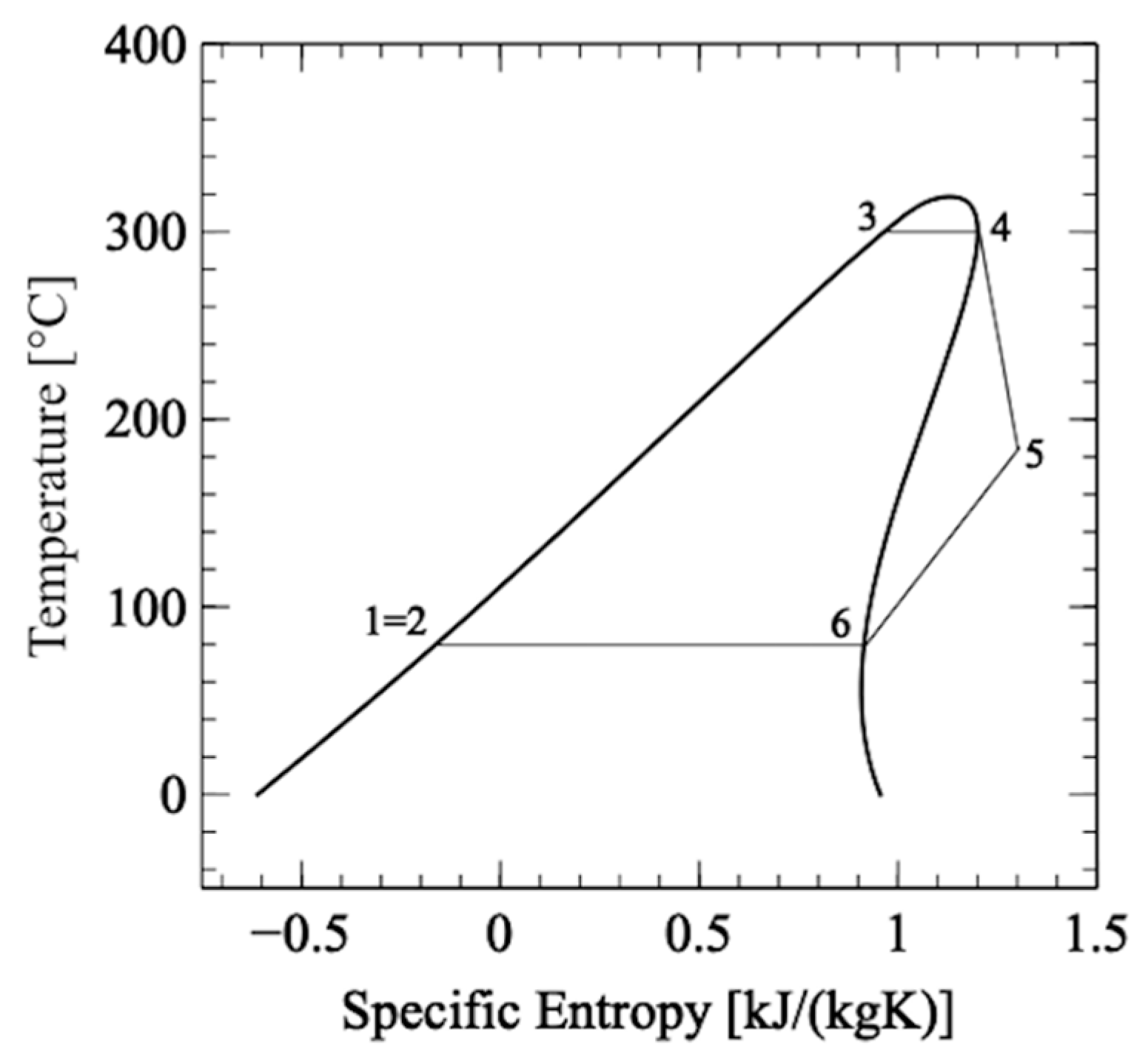
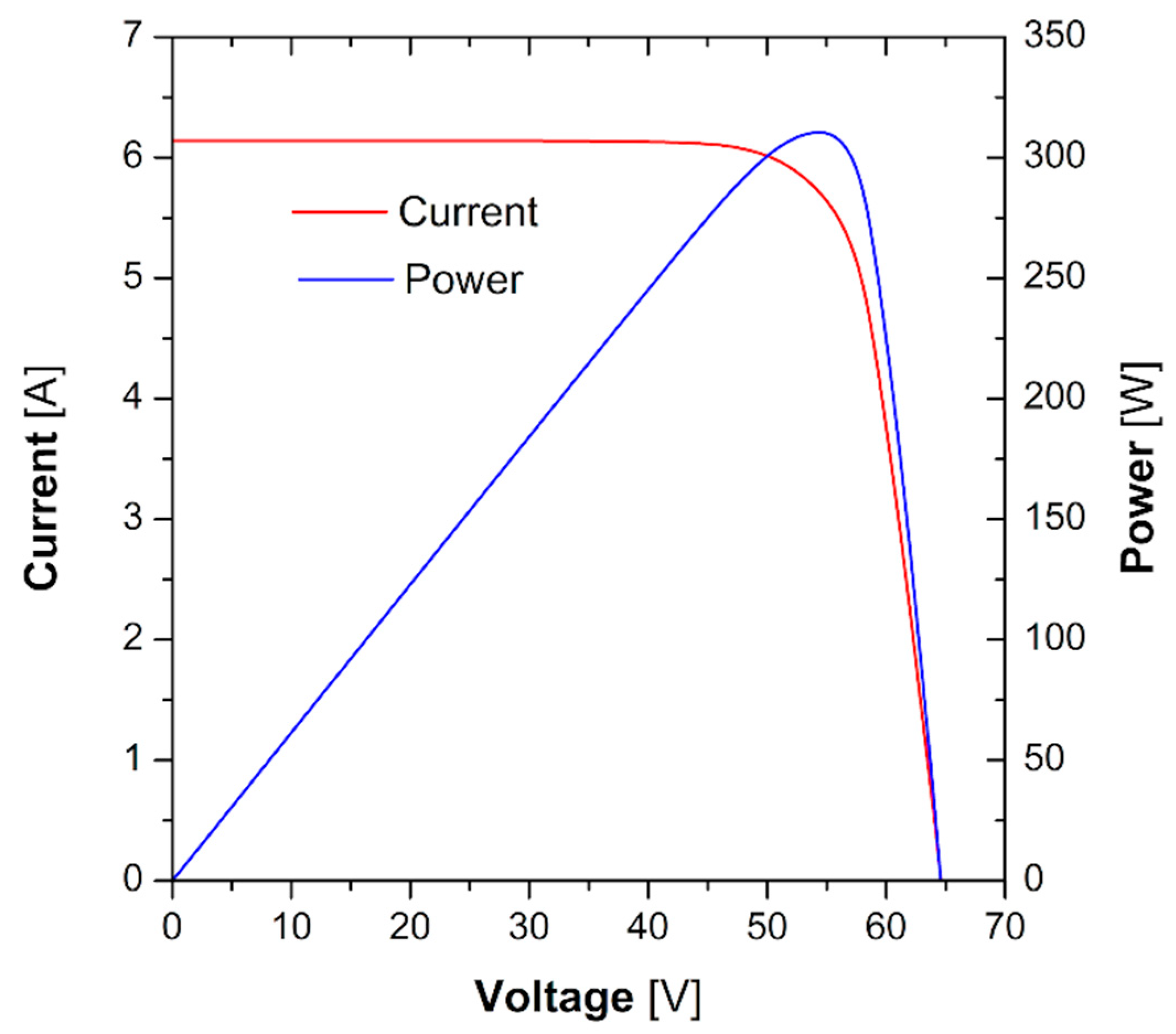
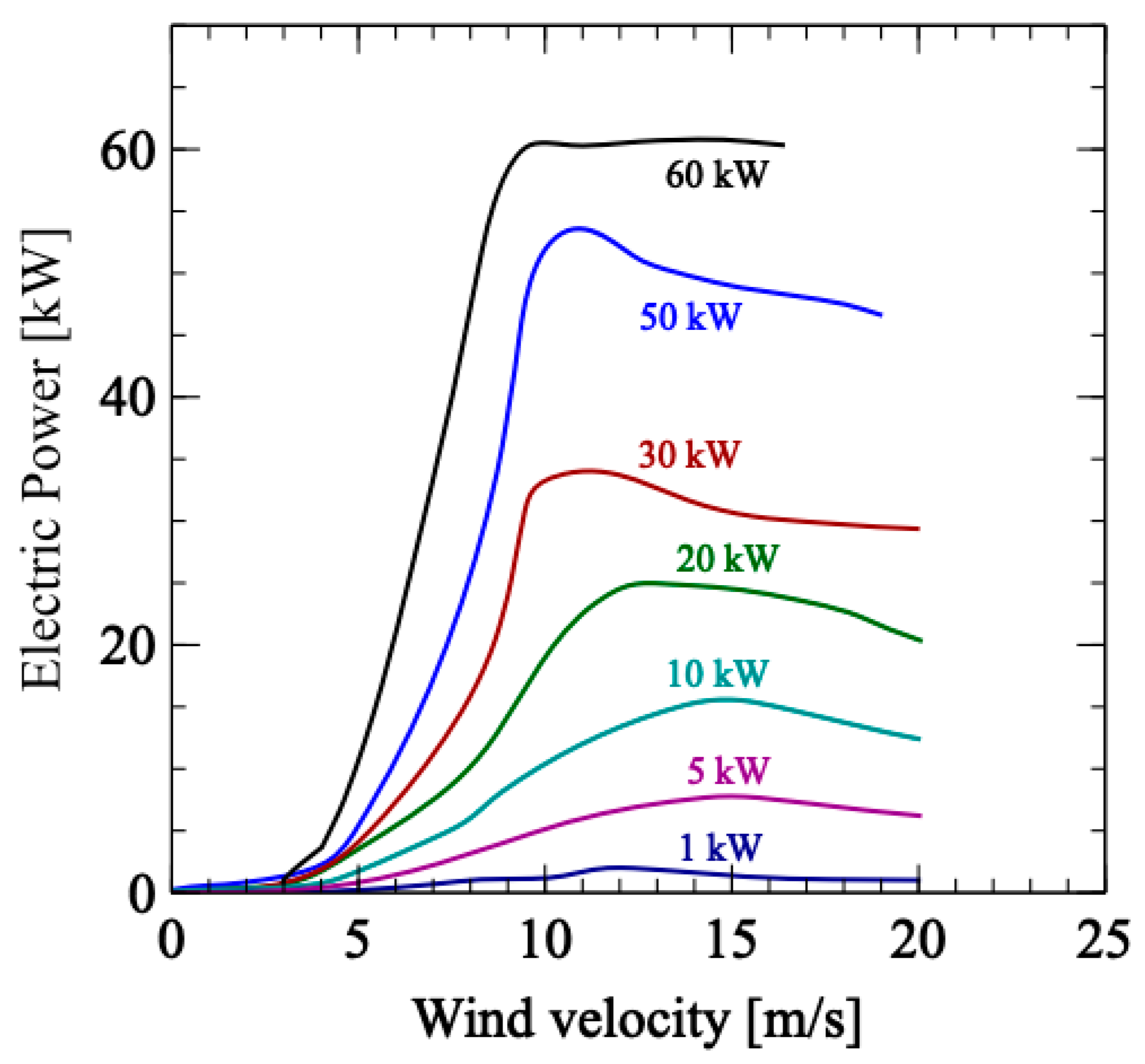
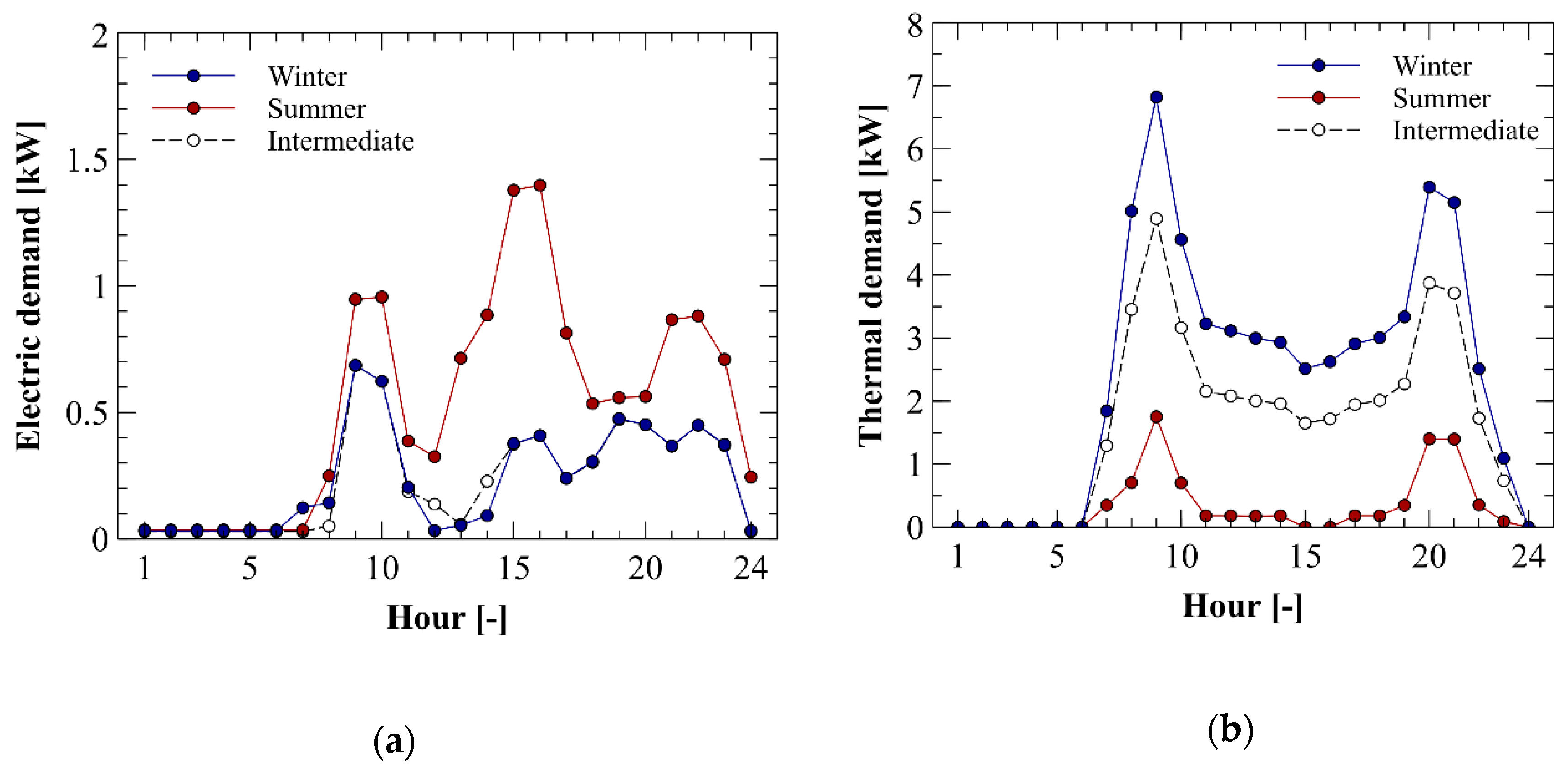


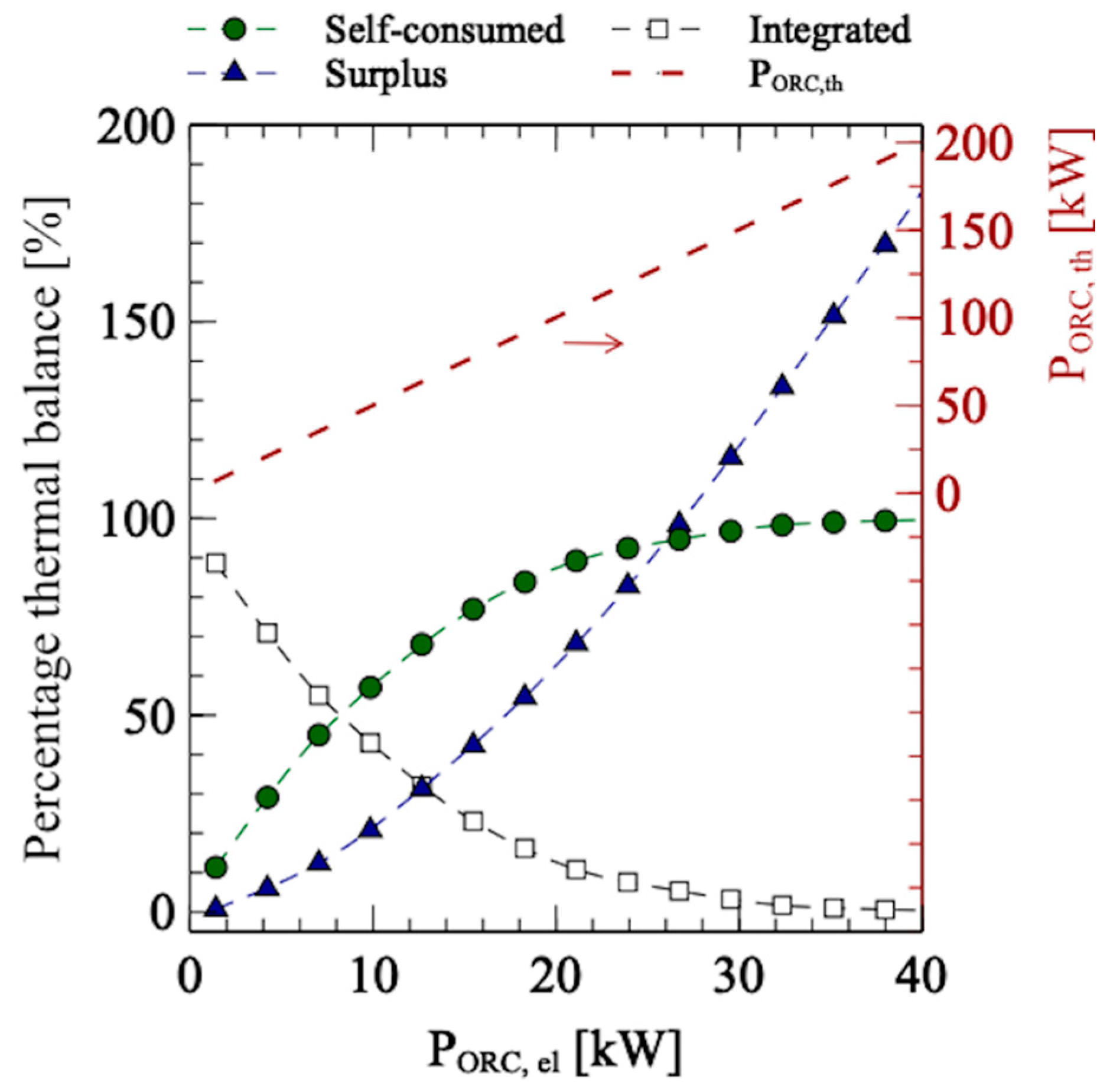
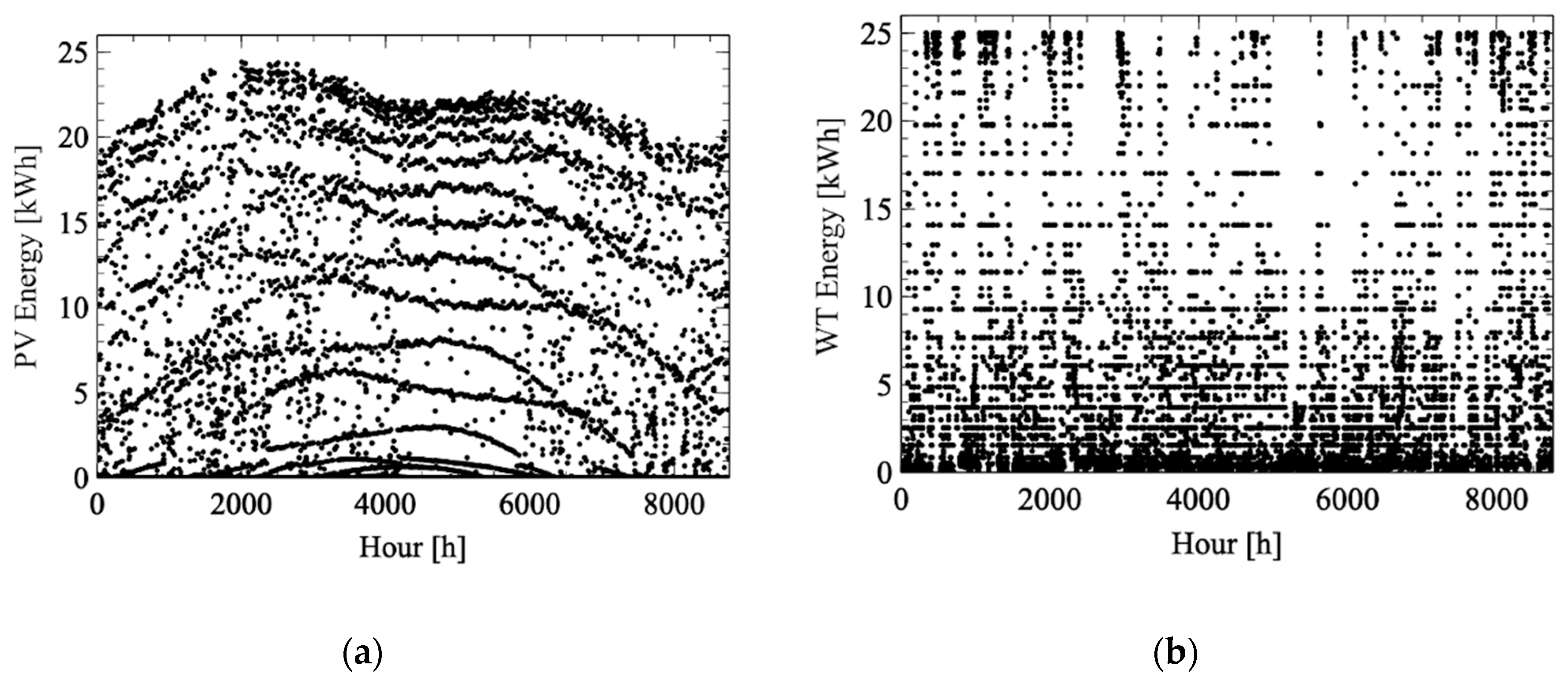
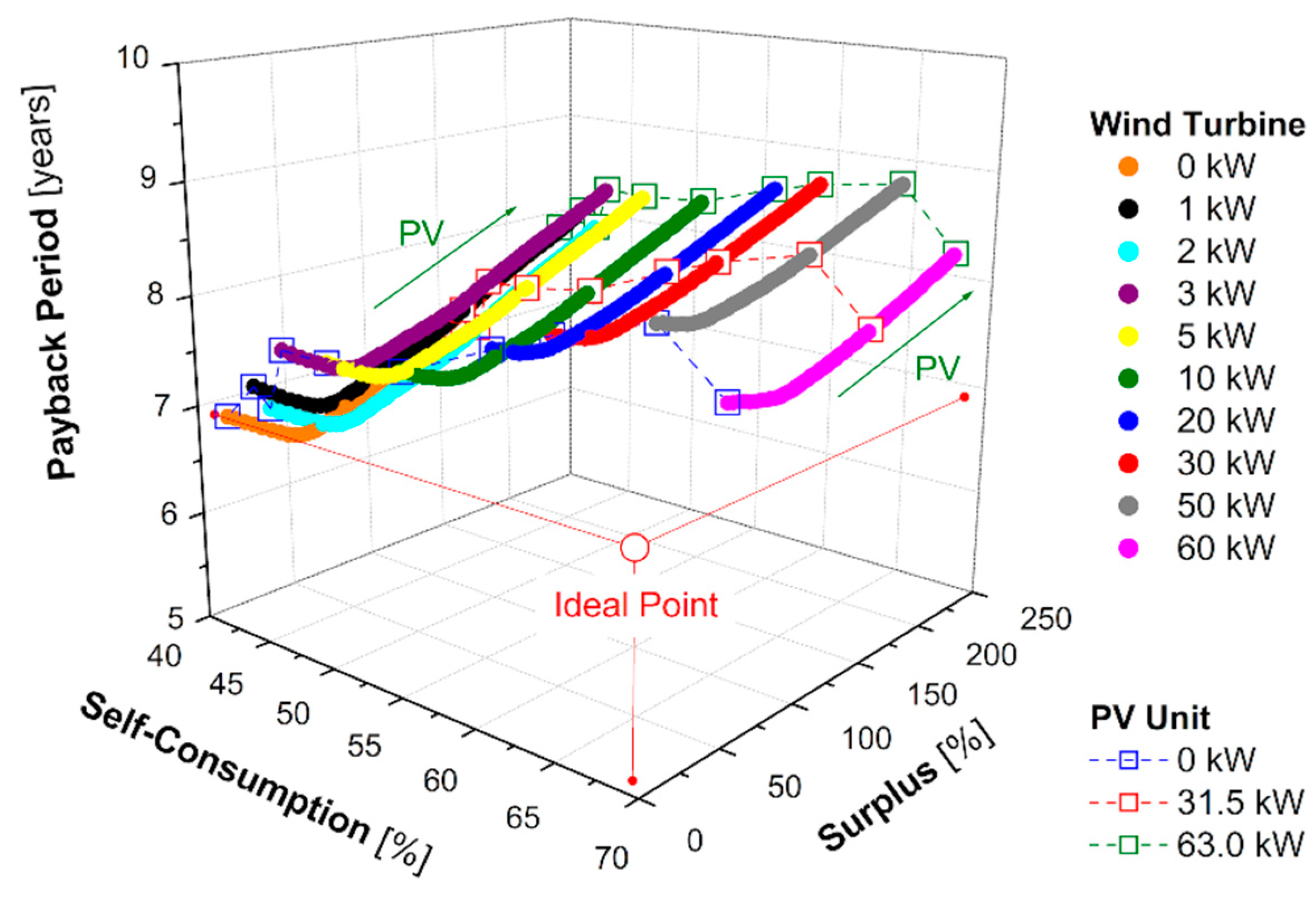
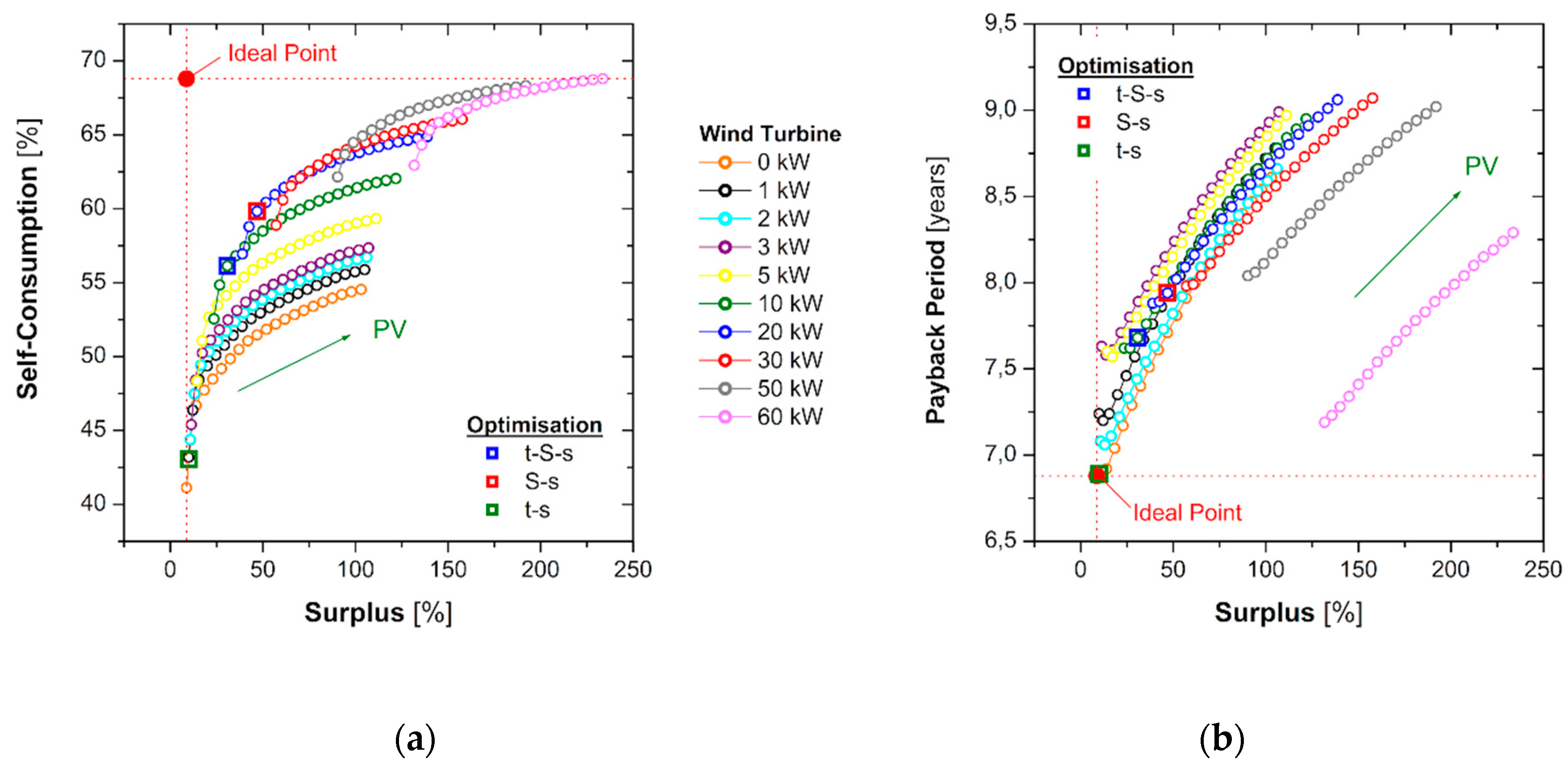
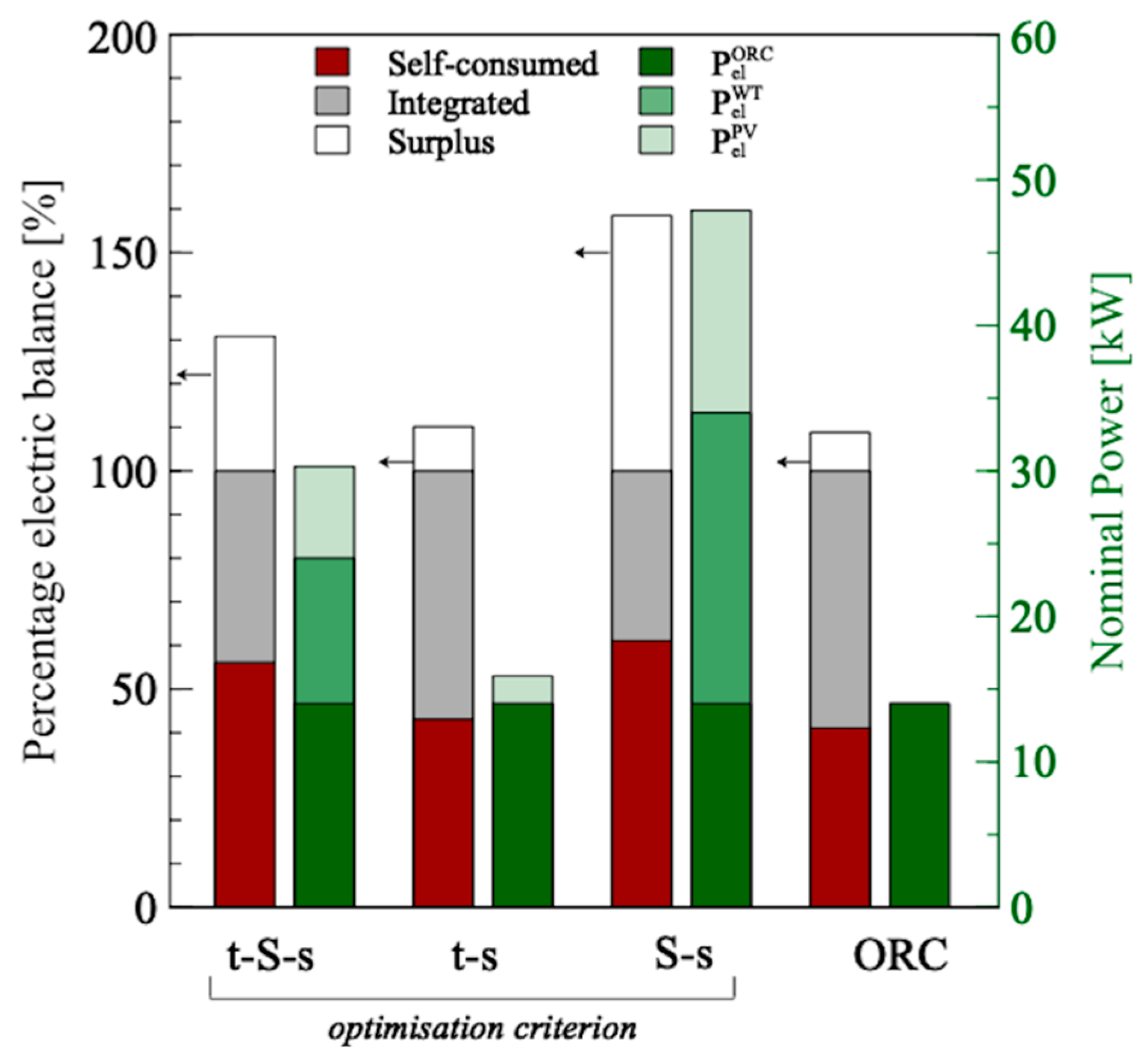
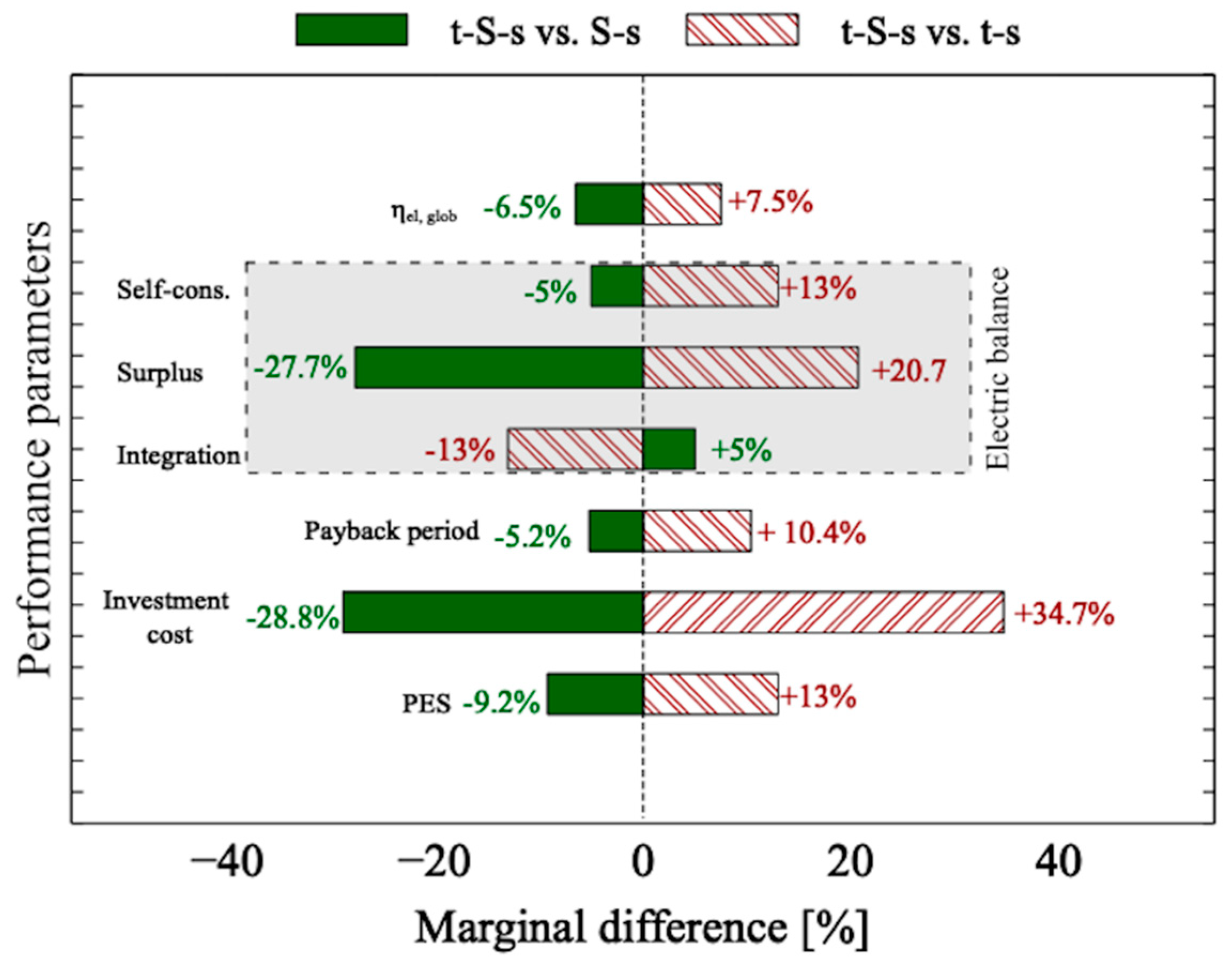
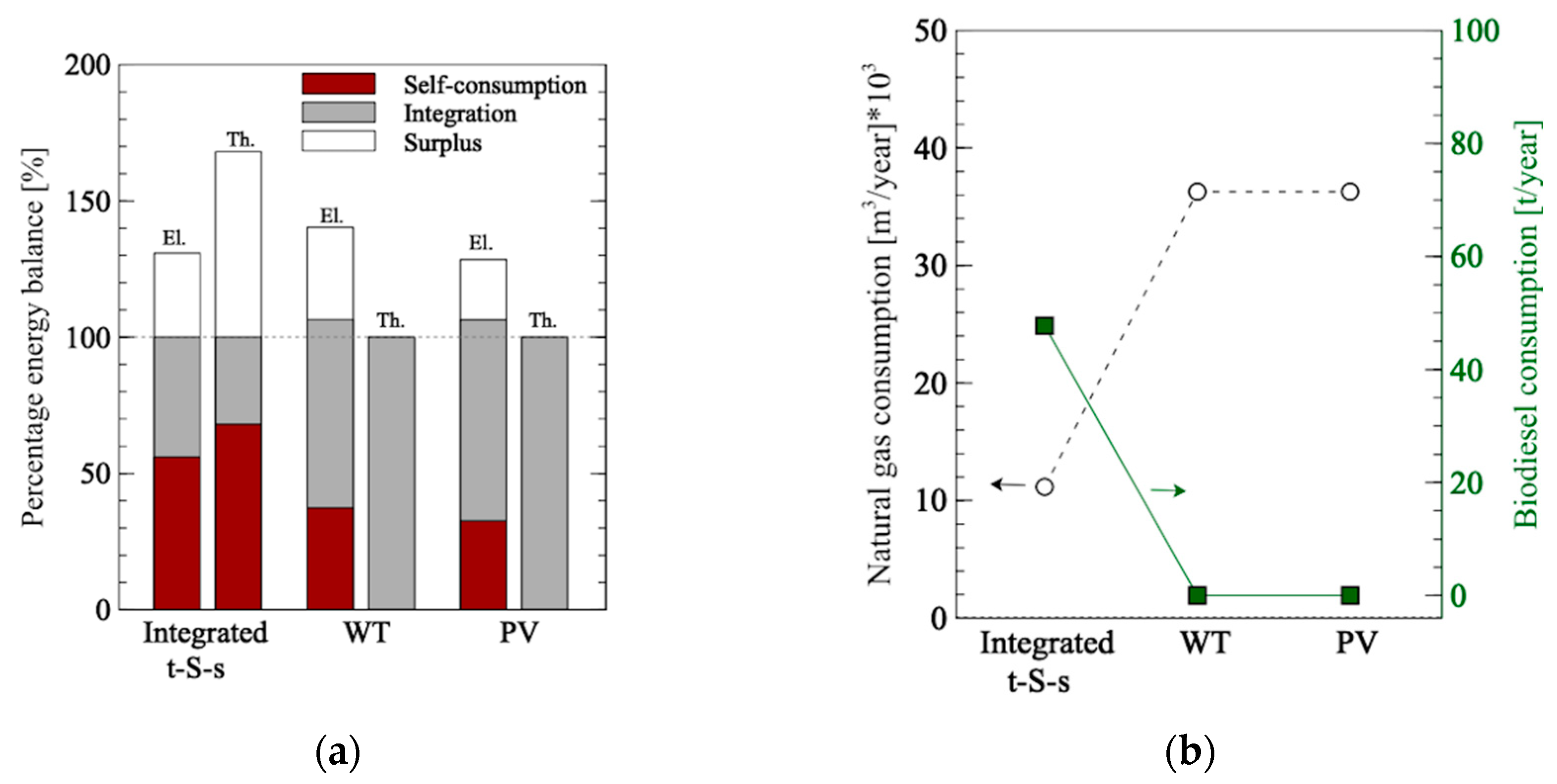
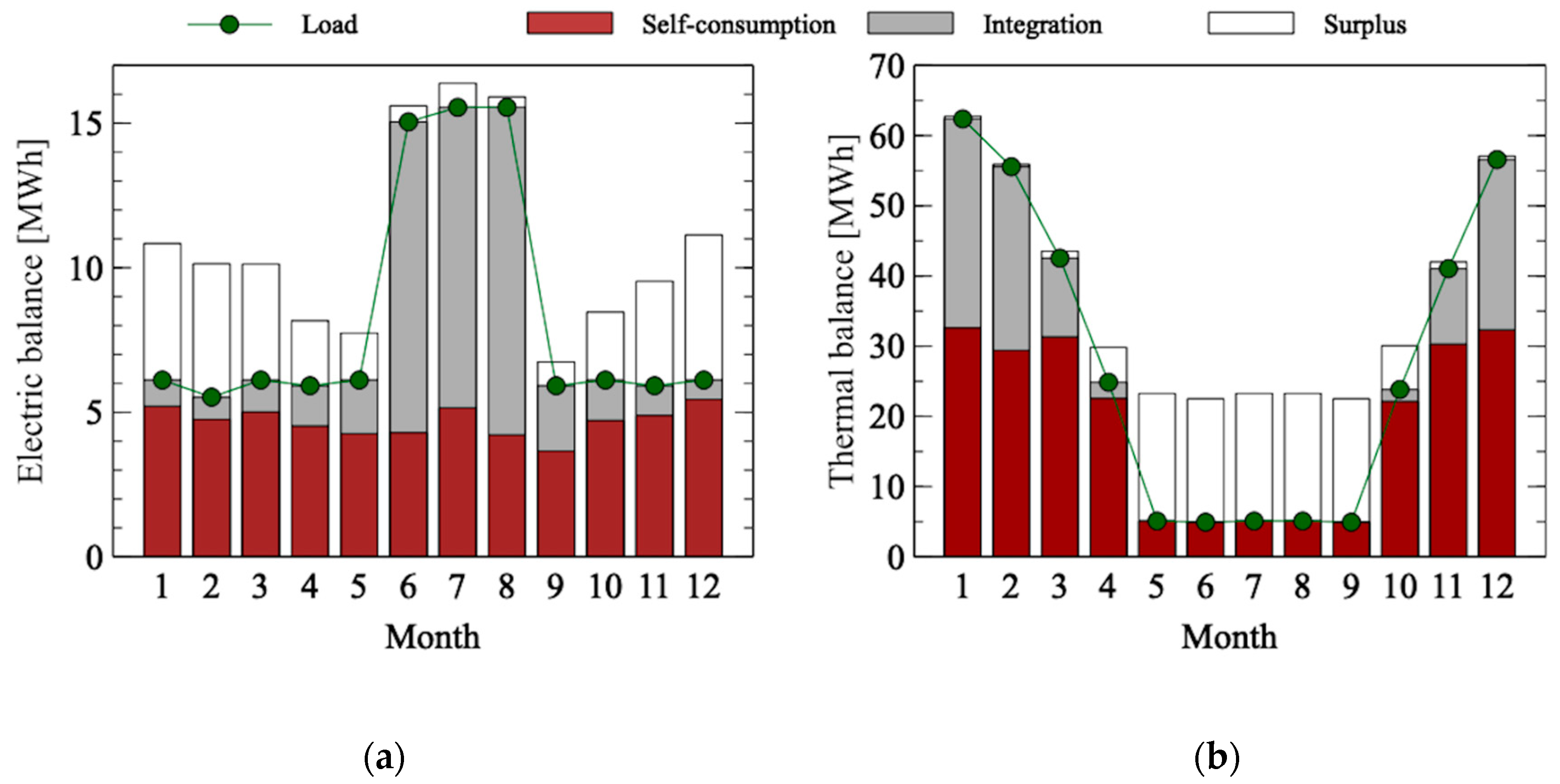
| ORC Configuration | Saturated | |
|---|---|---|
| Working fluid | Toluene | |
| Maximum temperature | (°C) | 150.0–300.0 |
| Maximum pressure | (bar) | 2.75–32.76 |
| Condensation temperature | (°C) | 80.0 |
| Condensation pressure | (bar) | 0.39 |
| Pump efficiency | (-) | 0.60 |
| Turbine efficiency | (-) | 0.70 |
| Boiler and thermal oil circuit efficiency | (-) | 0.85 |
| Electro-mechanical efficiency | (-) | 0.90 |
| Heat exchanger thermal efficiency | (-) | 0.95 |
| Electric reference efficiency | (-) | 0.33 |
| Thermal reference efficiency | (-) | 0.86 |
| Module Model | (-) | SunPower 315 |
|---|---|---|
| Module nominal power at STC | (Wp) | 315 |
| Module efficiency | (%) | 19.3 |
| Temperature coefficient | (%/°C) | −0.38 |
| Nominal operating cell temperature | (°C) | 45 |
| Module length | (m) | 1.559 |
| Module width | (m) | 1.046 |
| Number of modules | (-) | 1–200 |
| Module slope | (°) | 30 |
| Module orientation | (-) | South |
| Reflectance efficiency | (%) | 97.0 |
| Other components efficiency | (%) | 86.0 |
| Wind Turbines Models Aeolos-H | ||||||||||
|---|---|---|---|---|---|---|---|---|---|---|
| 1 kW | 2 kW | 3 kW | 5 kW | 10 kW | 20 kW | 30 kW | 50 kW | 60 kW | ||
| Nominal power | (kW) | 1 | 2 | 3 | 5 | 10 | 20 | 30 | 50 | 60 |
| Cut-in wind velocity | (m/s) | 2.5 | 2.5 | 2.5 | 2.5 | 2.5 | 2.5 | 3.0 | 3.0 | 3.0 |
| Rated wind velocity | (m/s) | 12 | 12 | 12 | 10 | 10 | 10 | 9 | 10 | 9 |
| Cut-off velocity | (m/s) | 25 | 25 | 25 | 25 | 25 | 25 | 25 | 25 | 25 |
| Rotor blade diameter | (m) | 3.2 | 4.0 | 4.8 | 6.4 | 8.0 | 10.0 | 15.6 | 18.0 | 22.4 |
| Investment Period | (Years) | 20 |
|---|---|---|
| Interest rate | (%) | 2 |
| Specific revenue for the saved thermal energy | (c€/kWhth) | 10 |
| Specific revenue for the saved electricity | (c€/kWhel) | 20 |
| Specific value of the electricity injected into the grid | (c€/kWh) | 10 |
| Specific cost of the electricity withdrawn from the grid | (c€/kWh) | 20 |
| Specific cost of natural gas | (c€/kWh) | 9.4 |
| Specific cost of biodiesel | (€/t) | 500 |
| Specific cost of ORC subsystem | (€/kWel) | 5000 |
| Specific cost of wind turbine | (€/kWel) | 2850 |
| Specific cost of photovoltaic subsystem | (€/kWp) | 1500 |
| Maintenance cost/Investment cost | (%) | 0.012 |
| Optimization Criterion | ||||
|---|---|---|---|---|
| t-S-s | S-s | t-s | ||
| Electric Power | (kWel) | 29.0 | 46.6 | 14.6 |
| ORC Electric Power | (kWel) | 12.7 | 12.7 | 12.7 |
| PV Electric Power | (kWp) | 6.3 | 13.9 | 1.9 |
| WT Electric Power | (kWel) | 10.0 | 20.0 | 0 |
| Thermal Power | (kWth) | 63.5 | 63.5 | 63.5 |
| Electric Production | (MWhel) | 86.9 | 119.6 | 53.1 |
| Thermal Production | (MWhth) | 329.7 | 329.7 | 329.7 |
| Electric Self-consumption | (%) | 56.1 | 61.1 | 43.1 |
| Electric Surplus | (%) | 30.8 | 58.5 | 10.1 |
| Electric Integration | (%) | 43.9 | 38.9 | 56.9 |
| Thermal Self-consumption | (%) | 68.0 | 68.0 | 68.0 |
| Thermal Surplus | (%) | 32.0 | 32.0 | 32.0 |
| Thermal Integration | (%) | 32.0 | 32.0 | 32.0 |
| Global efficiency | (%) | 17.5 | 24.0 | 10.0 |
| Energy Utilization Factor | (%) | 83.8 | 90.4 | 77.0 |
| Primary Energy Saving | (%) | 30.8 | 40.0 | 17.8 |
| Operating hours | (h) | 8760 | 7679 | 6663 |
| Minimum distance from WT | (m) | 144.5 | 162.4 | - |
| WT acoustic influence area | (m2) | 65,597.2 | 82,855.6 | - |
| Biodiesel consumption | (t) | 42.9 | 42.9 | 42.9 |
| Natural gas consumption | (m3) | 11,609 | 11,609 | 11,609 |
| Initial investment | (k€) | 101.2 | 130.4 | 66.1 |
| Net positive value | (k€) | 133.6 | 156.6 | 103.5 |
| Payback period | (years) | 7.7 | 8.1 | 6.9 |
© 2020 by the authors. Licensee MDPI, Basel, Switzerland. This article is an open access article distributed under the terms and conditions of the Creative Commons Attribution (CC BY) license (http://creativecommons.org/licenses/by/4.0/).
Share and Cite
Algieri, A.; Morrone, P.; Bova, S. Techno-Economic Analysis of Biofuel, Solar and Wind Multi-Source Small-Scale CHP Systems. Energies 2020, 13, 3002. https://doi.org/10.3390/en13113002
Algieri A, Morrone P, Bova S. Techno-Economic Analysis of Biofuel, Solar and Wind Multi-Source Small-Scale CHP Systems. Energies. 2020; 13(11):3002. https://doi.org/10.3390/en13113002
Chicago/Turabian StyleAlgieri, Angelo, Pietropaolo Morrone, and Sergio Bova. 2020. "Techno-Economic Analysis of Biofuel, Solar and Wind Multi-Source Small-Scale CHP Systems" Energies 13, no. 11: 3002. https://doi.org/10.3390/en13113002
APA StyleAlgieri, A., Morrone, P., & Bova, S. (2020). Techno-Economic Analysis of Biofuel, Solar and Wind Multi-Source Small-Scale CHP Systems. Energies, 13(11), 3002. https://doi.org/10.3390/en13113002






